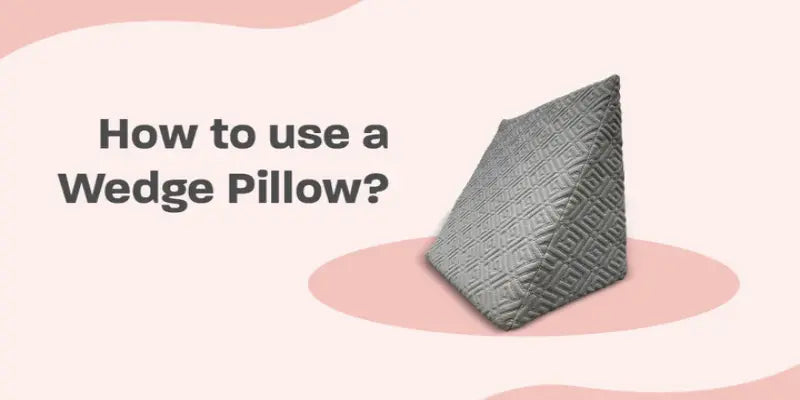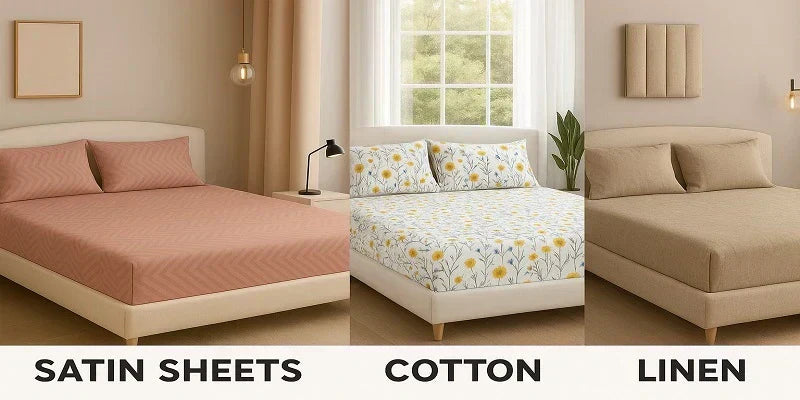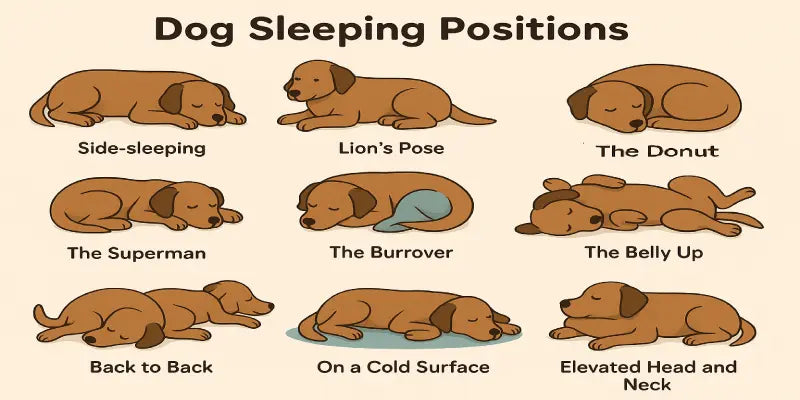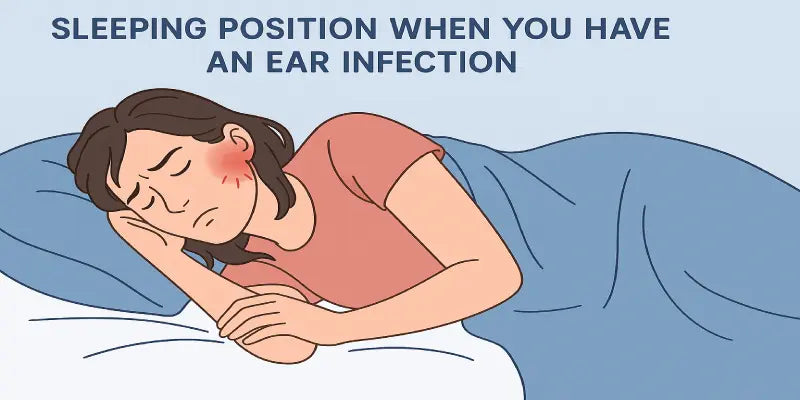
How to Use a Wedge Pillow?
A wedge pillow is a type of wedge-shaped pillow designed to put pressure on your body, including your hips. Wedge pillows are generally thought to provide the most support out of any type of pillow and can also help with reducing neck pain from sleeping on your back.
There are many ways to use a wedge pillow. You can use it as a neck pillow, a pregnancy pillow, or even a stomach sleeper pillow. You can also use it to reduce pain in your neck, shoulder, and back.
Uses of Wedge Pillows:
- Lie down on your back with your head and neck supported by the pillow.
- Put your arms above your head and relax your shoulders.
- Press the middle of the pillow against your forehead and temples.
- If you need more support, move the pillow up or down your neck.
How to Use a Wedge Pillow?

Here are a couple of ways to use a wedge pillow for better sleep and to make sitting up in bed more comfortable.
Upright Recline
If you are reading in bed and want to lay back on the incline, place a wedge pillow up against the wall. The wider end should be flat on the mattress, while the pointy end of the pillow should be against the side or headboard. The pillow will keep you reclined while maintaining a position where there is no pressure on your neck or back.
Experts recommend sitting in bed only when you mean to sleep, but sometimes it can't be avoided. If you use a wedge pillow, you won't have to rest against an uncomfortable wall, and will stay properly supported. The best wedge pillows for sitting up in bed have high surface angles between 43 and 45 degrees.
Elevated Back Sleeping
However, there’s a chance that your snoring and symptoms of sleep apnea can worsen when you’re lying on your back. When you lie down on your back, the back of your throat can sink in and collapse. This means that air may produce a loud sound as it passes through the tissue, or even cause you to have trouble breathing.
A wedge pillow can help improve sleep by making it easier to breathe and preventing the tongue from obstructing the airway. A wedge pillow is also useful for those with allergies or congestion, as it helps drain the sinuses more easily.
For those who have frequent stomach acid problems such as GERD and heartburn, there is potential for the acid to flow back up into the throat when lying down. However, using a wedge pillow can keep the acid moving downward so that there is less chance of it entering the throat and causing a burning sensation. It is important to find a pillow that has an incline of around 35-45 degrees, 8-10 inches above the mattress surface.
Elevated Side Sleeping
Side sleepers may develop apnea and reflux problems. These issues can be solved by using wedges that keep the spine neutral while minimizing pressure points and cradling the shoulders.
Leg Articulation When Back Sleeping
For those who are back sleepers, raising the legs while they are sleeping could help prevent varicose veins from forming. It can also reduce pressure on the lower back and relax your muscles. Furthermore, when circulation is improved, it can also be beneficial for people with heart disease and other serious medical issues.
Lap Placement
Occasionally, you might find yourself needing to work while in bed. To position your body, use a wedge pillow as a new desk. It helps if the thin part of the taper rests on your lap and the widest part near your knees is on top of your legs. Place an object on top of the pillow, such as a laptop or tablet, and it will rest comfortably so that you don't strain your wrists.
To use a wedge cushion as a neck pillow, first, position it between your neck and the headrest of your seat. Make sure that you have enough room between your neck and the edge of the wedge pillow so that you can relax your head and shoulders. If you are using the wedge as an eye pillow, make sure that it is placed behind your ears and against your forehead so that it supports your eyes and reduces pressure on your temples. Finally, if you are using the wedge as a stomach sleeper pillow, make sure that it is placed between your legs so that it supports your stomach and reduces pressure on your bladder.
What Are the Types of Wedge Pillows?

There are a few different types of wedge pillows, each with wedge pillow benefits and drawbacks. Here's a breakdown of the three most common types: traditional wedge pillows, C-shaped wedge pillows, and memory foam wedge pillows.
- Traditional Wedge Pillows: The traditional wedge pillow is the simplest type, consisting of a small, flat pillow placed between your legs and rested on your lower back. This type is the least comfortable because your head and upper body are unsupported, which can cause pressure points and headaches. Plus, it's not the most supportive because your weight isn't evenly distributed across the pillow.
- C-Shaped Wedge Pillows: The c-shaped wedge pillow is slightly more comfortable than the traditional wedge pillow because it supports your head and upper body better. It has two curves that create a space between your legs and your back, which distributes your weight more evenly. Additionally, this type of wedge pillow is easier to move around because it's shorter and wider than the traditional wedge pillow.
- Memory Foam Wedge Pillows: The memory foam wedge pillow is by far the most comfortable type of wedge pillow. It supports your head, neck, and spine perfectly, which relieves pressure points and headaches. Plus, this type of pillow is cooler than the other wedge pillow types because it’s made with foam and wrapped in foam. Thicker foam cushions are also more durable and supportive, which is why memory foam pillows are often sold at a higher price.
The Best Types of Wedge Pillows for Different Sleep Styles
There are many different types of wedge pillows, and each may work better for a different person. Whether you’re a side sleeper or a back sleeper, the type of wedge pillow you use can make all the difference in how comfortable you sleep.
Here are the three best types of wedge pillows for different sleep styles:
- Standard Wedge Pillow: This is the most common type of wedge pillow, and it’s designed to support your neck and spine in a typical sleeping position. It works best for people who sleep on their back or side.
- Fold-Up Wedge Pillow: This type of wedge pillow folds up into itself, so it’s smaller and easier to transport. It’s perfect for people who travel frequently or need to take their pillow with them on the go. It also works well for people who sleep on their stomach or side because it provides extra support to those areas.

- Snore Wedge Pillow: This type of wedge pillow is specifically designed to prevent snoring. It prevents your head from shifting while you sleep. It works for people who sleep on their back or side.
- Breathable Wedge Pillow: This type of pillow is made from hypoallergenic materials so it doesn’t cause any irritation to the skin. It works well for people who have allergies, especially those with sensitive skin.
- Comfort Wedge Pillow: This type of wedge pillow has a shape that conforms to your body shape and provides extra comfort to your head, neck, shoulders, and upper back. It also reduces pressure on the neck and shoulders while you sleep.
If you're looking for a way to increase your comfort and get a good night's sleep, consider using a wedge pillow. Wedge pillows are designed to redistribute weight so that you can rest more evenly on your spine, which in turn will help improve your posture and allow you to get better sleep.








